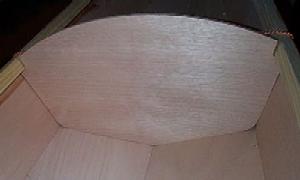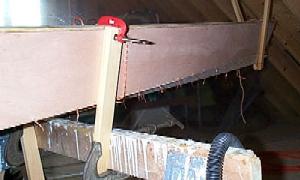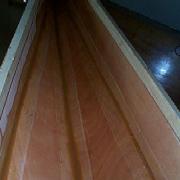



After the stitching, I wanted to check for proper hull shape. A spreader is inserted to achieve the beam required at the position of maximum beam. Even after careful wire tightening, it is found that the side panels do not follow the shape of the bulkheads. The forward bulkhead may be able to be drawn in (as shown by the rope). Aft, the side panels have too much flare(3/8 inch per side at the shear clamp).
Am I missing something? Time for a quick e-mail to CLC Boats.
John at CLC has the theory that the wood in my shear clamps may be a
little "springy", causing the gap at the side panels. The plan at this
point is that I will do whatever is necessary to achieve a fair hull shape,
even if I need to trim this panel and move it aft. I do not want a boat
with dips and bulges in it.
 Finally, I am
satisfied with the shape of the hull. In this picture, the hull has been
hung by the shear clamps to avoid distorting the keel. Forward, two pieces
of wood have been tied into a 'vee' to clamp the panels into the desired
shape near the bow. A similar arrangement clamps the stern. "Winding" refers
to the process of sighting along the panels to check for and eliminate
twist in the hull. The hull shape will soon be permanent.
Finally, I am
satisfied with the shape of the hull. In this picture, the hull has been
hung by the shear clamps to avoid distorting the keel. Forward, two pieces
of wood have been tied into a 'vee' to clamp the panels into the desired
shape near the bow. A similar arrangement clamps the stern. "Winding" refers
to the process of sighting along the panels to check for and eliminate
twist in the hull. The hull shape will soon be permanent.
 Next, epoxy
and wood flour are mixed to the consitency (and nearly the same color)
as peanut butter. This compound is spread into the corners, forming fillets.
Later, glass fiber tape is applied over the seams, and unthickened epoxy
wets the tape.
Next, epoxy
and wood flour are mixed to the consitency (and nearly the same color)
as peanut butter. This compound is spread into the corners, forming fillets.
Later, glass fiber tape is applied over the seams, and unthickened epoxy
wets the tape.